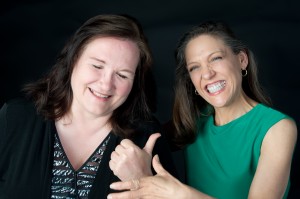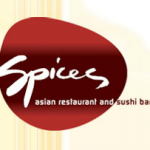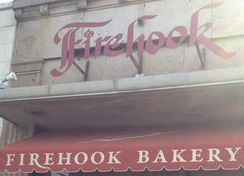Nosidekick
Playwrites Sarah Kellogg and Cynthia Wilcox and No Sidekick
Why collaboration? Because collaboration works.
 Together we’re able to promote innovation, share knowledge and work cooperatively toward a common goal. For us, collaboration is more than the buzzword of the moment, it is a way to take our individual ideas and transform them into shared creative projects. As friends, our path to a creative collaboration was made easier because we knew each other, but some might argue that a friendship makes it more difficult. Whether friends or colleagues, the crucial element to a great collaboration is trust and respect. We recommend that you lay out the rules before you start, and keep the communication lines open to ensure that disagreements are handle swiftly and thoroughly.
Together we’re able to promote innovation, share knowledge and work cooperatively toward a common goal. For us, collaboration is more than the buzzword of the moment, it is a way to take our individual ideas and transform them into shared creative projects. As friends, our path to a creative collaboration was made easier because we knew each other, but some might argue that a friendship makes it more difficult. Whether friends or colleagues, the crucial element to a great collaboration is trust and respect. We recommend that you lay out the rules before you start, and keep the communication lines open to ensure that disagreements are handle swiftly and thoroughly.
A Collaborative Mindset
 Collaboration works best when both people – or a group – are open to learning, listening and working through the creative process. Both parties need to align their own desires with the greater needs of the collaborative team. By defining expectations and roles at the beginning, the final product will be the result of a committed team with clearly established objectives. Creative collaboration takes work, and team members need to be willing to set aside their own separate goals to ensure that the project goals are met, first and foremost.
Collaboration works best when both people – or a group – are open to learning, listening and working through the creative process. Both parties need to align their own desires with the greater needs of the collaborative team. By defining expectations and roles at the beginning, the final product will be the result of a committed team with clearly established objectives. Creative collaboration takes work, and team members need to be willing to set aside their own separate goals to ensure that the project goals are met, first and foremost.
Friends or Collaborators?
 Not every collaborator needs to be a friend, but it has been a winning formula for us. Friendship isn’t enough, however. It takes more than a solid friendship to guarantee the success of a creative team. Some people say that friendship can be distracting, and we’ve had our share of creative meetings that have evolved into friendship chat sessions. It has not, however, been an impediment when making touch decisions. Whether friends or colleagues, the key to successful teamwork is trust and communication. Because our friendship is built on a foundation of trust, it has made it much easier to collaborate as creative peers. It also has helped in divining the contributions of both partners. Because we are friends, we clearly know the other person’s skills and wishes.
Not every collaborator needs to be a friend, but it has been a winning formula for us. Friendship isn’t enough, however. It takes more than a solid friendship to guarantee the success of a creative team. Some people say that friendship can be distracting, and we’ve had our share of creative meetings that have evolved into friendship chat sessions. It has not, however, been an impediment when making touch decisions. Whether friends or colleagues, the key to successful teamwork is trust and communication. Because our friendship is built on a foundation of trust, it has made it much easier to collaborate as creative peers. It also has helped in divining the contributions of both partners. Because we are friends, we clearly know the other person’s skills and wishes.
Collaboration Tools
Unlike many of our friends and colleagues, we believe the secret to great collaboration isn’t technology, unless you consider old-fashioned conversation a technology. While we appreciate technological tools in the workplace, we believe our success tracks back to our ability to speak face to face about creative ideas and projects. That doesn’t mean that we can’t work across the miles, and we have done that, but the critical brainstorming sessions that are the heart of our partnership are done sitting across from each other. That’s why we are big fans of creating or finding a collaborative landscape that supports brainstorming and writing.
A Collaborative Landscape
 The essence of good collaboration is creating an environment where creativity can happen. Our favorite landscape for creating is Spices, a Pan Asian restaurant in Cleveland Park in Washington, D.C. All of our plays begin and end here. We’ve turned it into our artistic Cheers, a welcoming space with a friendly staff and good food.
The essence of good collaboration is creating an environment where creativity can happen. Our favorite landscape for creating is Spices, a Pan Asian restaurant in Cleveland Park in Washington, D.C. All of our plays begin and end here. We’ve turned it into our artistic Cheers, a welcoming space with a friendly staff and good food.
 Sometimes the best place for brainstorming turns out to be a historic bakery in Chicago–one that you’ve never been to before and one you certainly hope has good coffee. Dinkles is that place. We finished up key editing on Authentic Volpi, the Italian cookbook for the John Volpi, Co. of St. Louis, with coffee and tea in hand and some confection that neither of us really needed.
Sometimes the best place for brainstorming turns out to be a historic bakery in Chicago–one that you’ve never been to before and one you certainly hope has good coffee. Dinkles is that place. We finished up key editing on Authentic Volpi, the Italian cookbook for the John Volpi, Co. of St. Louis, with coffee and tea in hand and some confection that neither of us really needed.
 Cleveland Park is one of those rare neighborhoods. You have the lively spirit of the city, but you also have a hometown feel where you know your neighbors and you can get a cup of coffee without being inundated with the scrappy edges of the city. Firehook is another one of our landscapes for collaboration. A comfortable environment, nice staff and good food.
Cleveland Park is one of those rare neighborhoods. You have the lively spirit of the city, but you also have a hometown feel where you know your neighbors and you can get a cup of coffee without being inundated with the scrappy edges of the city. Firehook is another one of our landscapes for collaboration. A comfortable environment, nice staff and good food.
When Things Don’t Work
 There is no guarantee that every moment spent in collaborative partnership will be a success. Even people who like each other and have solid friendships disagree, so it’s critical that you set up rules to ensure that each person on the team can express their needs, goals and desires. It’s also essential to set up a rule around what “no” means. Let’s say one of the collaborators doesn’t agree, does the project or idea still go forward? Probably not. No idea is so valuable that it should have the power to sink the team, so we encourage you to set up some rules of the game about when “no” means “no” and what a “no” means. (Sometimes your best option, of course, is to say: “This is all her fault.”)
There is no guarantee that every moment spent in collaborative partnership will be a success. Even people who like each other and have solid friendships disagree, so it’s critical that you set up rules to ensure that each person on the team can express their needs, goals and desires. It’s also essential to set up a rule around what “no” means. Let’s say one of the collaborators doesn’t agree, does the project or idea still go forward? Probably not. No idea is so valuable that it should have the power to sink the team, so we encourage you to set up some rules of the game about when “no” means “no” and what a “no” means. (Sometimes your best option, of course, is to say: “This is all her fault.”)